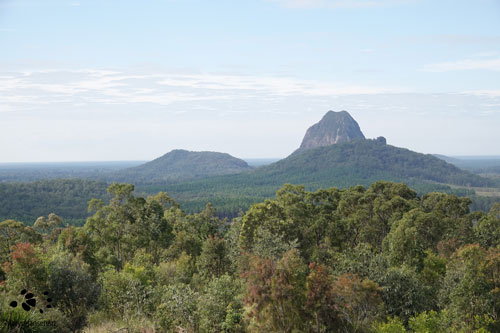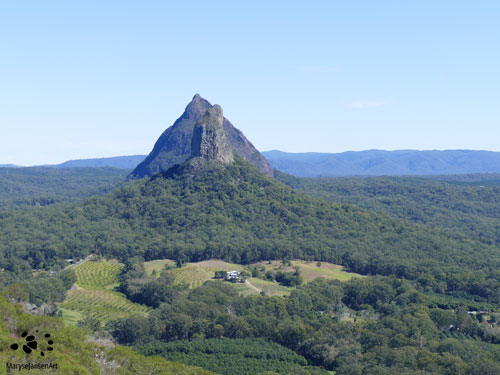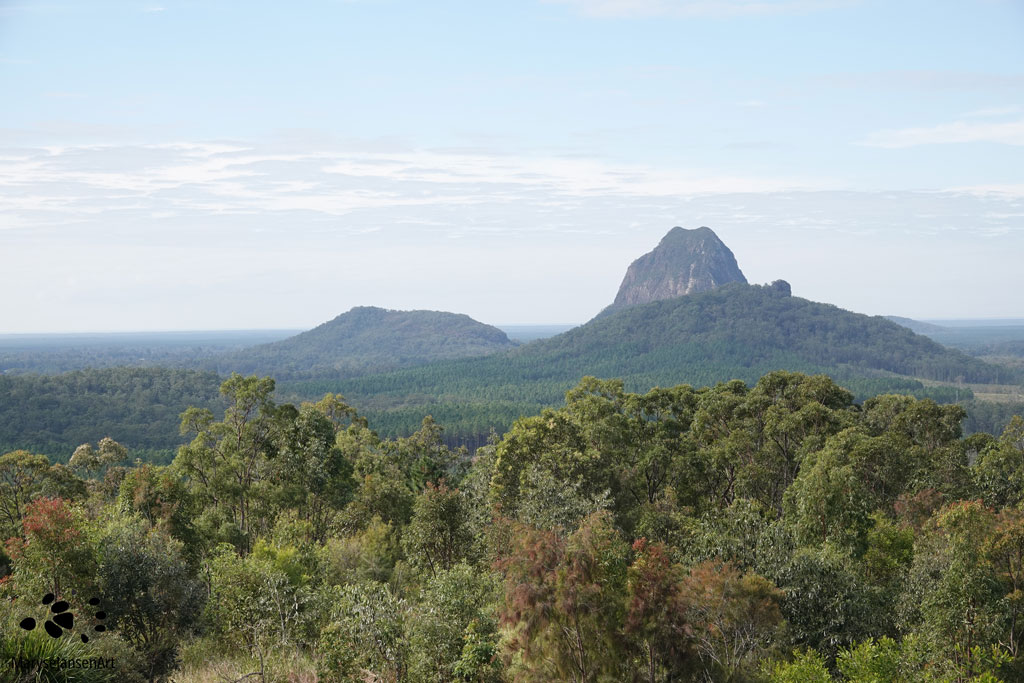Landscape Photography with marysejansenart
Take a walk at the Glass House Mountains Lookout

Glass House Mountains National Park
From whichever direction you look, the Glass House Mountains’ awe-inspiring peaks dominate the south-east Queensland coastal plain, rising up in their magnificent shapes. No wonder they have played a significant role in people’s lives throughout history, and continue to do so to this day.
Volcanic activity formed them 26-27 million years ago. What you see now is the rhyolite and trachyte plugs of these extinct volcanoes. The softer rocks that once shaped their exterior have eroded away over time.
Captain James Cook named them the Glass House Mountains when he first laid his eyes on them, because reminded him of the huge glass furnaces (glasshouses) back home.
Long before that moment of course, the mountains have been a significant site for Indigenous people through time and their beautiful names come from the Aboriginal language. There are many Dreamtime stories about the part the mountains have played in the creation of the land as it is now. I share one of these stories in my free e-book, so if you haven’t subscribed to my blog yet, make sure you click the button below in order to receive your free copy!
The Glass House Mountains are also of environmental significance because, like Mt Coolum, they host a great number of rare and threatened species of vegetation. Especially the montane heath areas are significant, with 26 rare species recorded! The park also provides a refuge for wildlife, such as the vulnerable Glossy Black Cockatoo and a number of vulnerable species of frogs.
The area became a National Park in 1994. Living only a 45 minute drive away from this amazing National Park, I have visited it a good number of times. Not every peak is accessible to the public, but there are a good number of bush walking tracks available.
Bushwalking in the Glass House Mountains
Most walks are associated with the third highest peak, Mt Tibrogargan (364m). It is the highest mountain in the featured image. I took you along on one of these walks last summer, when we had a look at the variety of yellow wildflowers that brightened up the forest along the Trachyte track (read more).
I also took you there last week, when we walked around the base of the mountain and encountered the signs of a recent bushfire. We also got some nice views along the way on some of the other peaks (read more). Today, I take you for a walk at the Glass House Mountains Lookout, and from this place we get a great view on most of the peaks.
The second highest peak is Mt Coonowrin (377m). Since 1999 this one has been closed to the public due to the unstability of the rocks. But we can enjoy its marvellous shape from a distance.
The highest peak is Mt Beerwah (556m), it’s one of the most distinctly shaped cones. There are no regular walking tracks here, but there is a summit track for experienced climbers. As with the summit track of Mt Tibrogargan, this track needs to not be underestimated. There is serious danger of rock fall, which currently has the Mt Beerwah track closed.

In the image above you can see Mt Coonowrin in front of Mt Beerwah. I was able to get this interesting perspective from the top of Mt Ngungun (253m). The climb to the top of Mt Ngungun is not as tricky. It’s mostly a walking track, but there is still a bit of scrambling involved to get to the actual top. From there, you can get an amazing 360 degree view! It’s been a while since I’ve been there, but if I go again I will create an episode of ‘Come for a walk in the Australian Bush’ for you!
Thirteen Peaks
Where Mt Beerwah is composed of alkali trachyte, Mt Tibrogargan and Mt Coonowrin are composed of alkali rhyolite. Other trachyte peaks are Mt Miketeebumulgrai and Mt Beerburrum. Other rhyolite peaks are Mt Cooee, Mt Ngungun, Mt Coochin, Mt Tunbudla, Mt Tibberoowucum and Mt Elimbah. Unknown to me is the composition of Round Mountain and Wild Horse Mountain.
As you can deduce now, there is a total of 13 named peaks in the area. Coochin and Tunbudla both have two summits and are respectively known as the Coochin Hills and the Twins. Ten of these peaks we can observe from the Glass House Mountains Lookout. I invite you to watch the video below and see for yourself!
If you are interested in purchasing ‘Glass House Trio’ or would like to see what the image looks like on the various products, please head to my shop. For ‘Beerwah and Coonowrin’ and other images that feature the Glass House Mountains, check out my Landscapes Collection here.


